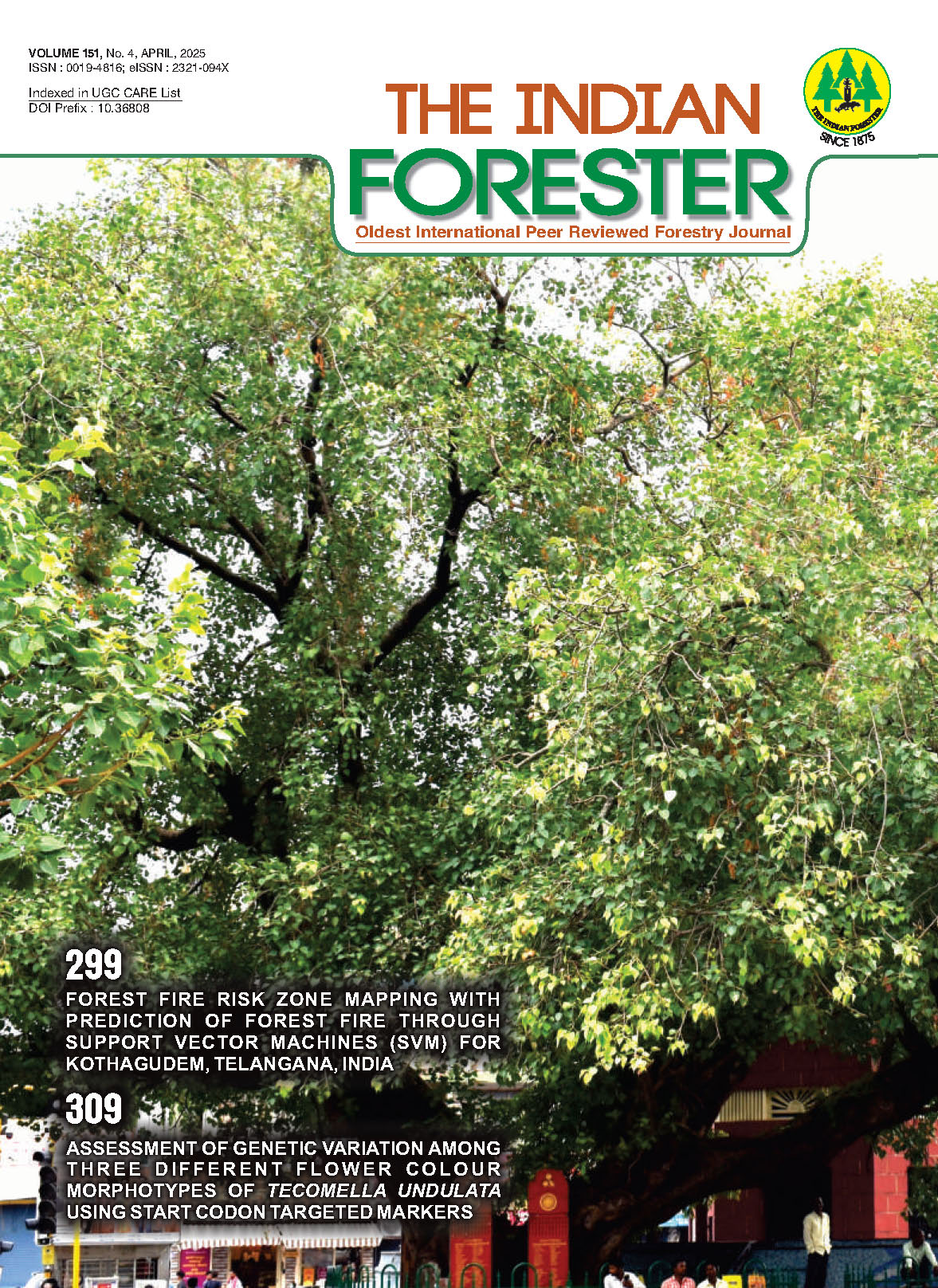Gregarious flowering of Bambusa tulda in North East India
DOI:
https://doi.org/10.36808/if/2025/v151i4/170607Keywords:
No Keywords.Abstract
No Abstract.
References
Banik R.L. (2020). Distribution, diversity and prospects for propagation of industrially suitable bamboo species in India. Journal of Bamboo and Rattan, 19(3):52 – 69.
Barooah C. (1999). Flowering of bamboos in Assam. Indian Forester, 125(5):543:544.
Bhattacharya S., Das M., Bar R. and Pal A. (2006). Morphological and molecular characterization of Bambusa tulda with a note on flowering. Annals of Botany, 98(3): 529535. DOI: https://doi.org/10.1093/aob/mcl143
Chauhan N.P.S. (2003). Observations on bamboo flowering and associated increases in rodent population in the north eastern region of India. In: Rats, Mice and People: Rodent Biology and Management. Australian Centre for International Agricultural Research, Canberra, Australia. Monograph No. 96: 267-270.
Chauhan N.S. and Saxena R.N. (1985). The phenomenon of bamboo flowering and associated increase in rodent population in Mizoram. Journal of the Bombay Natural History Society, 82(3): 644-647.
Das M.C. (2021).Sporadic flowering of Bambusa tulda Roxb. Indian Forester, 147(6):602-604. DOI: https://doi.org/10.36808/if/2021/v147i6/154610
Gupta K.K. (1987). Gregarious flowering of Oxytenanthera spp. Indian Forester, 113: 385.
Konyak P.M. (2022). Introduction of Bambusa tulda Roxb. along with shifting cultivation as a sustainable bioresource in North East India. Current Science, 123(1):97-100. DOI: https://doi.org/10.18520/cs/v123/i1/97-100
Kumar S. and Nath S. (2011). Flowering of Bambusa tulda Roxb. at Ranchi, Jharkhand. Indian Forester, 137(6):802.
Kumawat M.M., Singh K.M., Tripathi R.S., Riba T., Singh S. and Sen D. (2014). Rodent outbreak in relation to bamboo flowering in north-eastern region of India. Biological agriculture & horticulture, 30(4):243-252. DOI: https://doi.org/10.1080/01448765.2014.925828
Mohan Ram and Gopal B.H. (1981). Some observations on the flowering of bamboos in Mizoram. Current Science, 50(16):708-710.
Naithani H.B. (1993). Contribution to the Taxonomic Studies of bamboos in India. PhD Thesis. HNB Garhwal University, Srinagar.
Naithani H.B. (2007). Nomenclature and distribution of bamboo Oxytenantheraparvifolia in India. Indian Forester, 133(7):993996.
Naithani H.B. (2011). Bamboos of Nagaland, Pp. 1- 205. NEPED and NBDA, Kohima, Nagaland.
Naithani H.B. (2020). Bamboos of Meghalaya, Pp. 1- 238. Silviculture Division, Research and Training Wing, Department of Forest & Environment, Shillong, Meghalaya.
Naithani H.B., Deka A.K. and Banerjee G. (2013). Gregarious flowering of bamboos in Arunachal Pradesh. Indian Forester, 139(8):746-749.
Naithani H.B., Rao P.V.C and Reddy B.V.P (2012). Bambusa tulda Roxb., Report of Gregarious Flowering from South India. Indian Forester, 138(5):484-485.
Nautiyal D.P., Nautiyal S. and Chaukiyal S.P. (2008). Indication of gregarious flowering in Bambusa tulda in North-Eastern states of India. Indian Forester, 134(7):985-986.
Parry N.E. (1931). On the flowering of bamboos. Journal of Bombay Natural History Society, 34:1099-1101.
Prasad J. (1948). Silviculture of ten species of bamboo for paper manufacture. Indian Forester, 74(3):122-130.
Rawat B.S. (1987). Flowering of bamboos. Indian Forester, 113:760-761.
Sarma H., Sarma A.M., Sarma A. and Borah S. (2010). A case of gregarious flowering in bamboo, dominated lowland forest of Assam, India: phenology, regeneration, impact on rural economy, and conservation. Journal of Forestry Research, 21(4): 409-414. DOI: https://doi.org/10.1007/s11676-010-0090-3
Sasikumar K, Devi S.M. and Saha A. (2015). Bamboos of Tripura.Moumita Prakashani, Bordowali, West Tripura.
Seethalakshmi K.K. and Kumar M.M. (1998). Bambusa tulda. In: Bamboos of India: A compendium, Kerala Forest Research Institute, Peechi. Technical Report No.17:79-83. DOI: https://doi.org/10.1163/9789004627970
Singh K.P., Devi S.P., Devi K.K., Ningombam D.S. and Athokpam P. (2010). Bambusa tulda Roxb. in Manipur State, India: exploring the local values and commercial implications. Notulae Scientia Biologicae, 2(2): 35-40. DOI: https://doi.org/10.15835/nsb224623
Sridhara S. and Rajendran T.P. (2010). Gregarious Bamboo Flowering and Rodent Outbreaks–An Overview. In: Proceedings: 24th Vertebrate Pest Conference, Davis. 2010. University of California, Davis. DOI: https://doi.org/10.5070/V424110341
Srivastava N., Kumar S., Kumar S., Das R. and Nath S. (2012). Silvicultural management for seed setting in sporadically flowered Bambusa tulda Roxb. Journal of Bamboo and Rattan, 11(1-4):1-11.
Vanlalfakawma D.C., Malsawmkima B. and Tripathi S.K. (2021). Gregarious flowering of a geriatric semelparous bamboo - Bambusa tulda Roxb. in Mizoram, India. Current Science, 120(7): 1142-1143.
Zheng X., Lin S., Fu H., Wan Y. and Ding Y. (2020). The bamboo flowering cycle sheds light on flowering diversity. Frontiers in Plant Science, 11:381. doi: 10.3389/fpls.2020.00381 DOI: https://doi.org/10.3389/fpls.2020.00381
Downloads
Downloads
Published
How to Cite
Issue
Section
License
Unless otherwise stated, copyright or similar rights in all materials presented on the site, including graphical images, are owned by Indian Forester.





